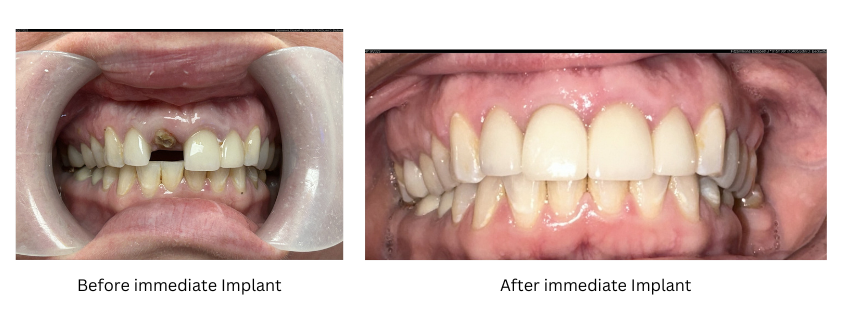It often happens so quickly—a sudden fall, sports injury, accident, or trauma. One minute everything is fine and the next, a tooth is damaged beyond repair and needs to be removed. Traditionally, whether with implants or other restorative techniques, the tooth replacement and healing process could take several months. But now there is another option called immediate implants which can speed up the process and restore your smile right away.
What are immediate implants?
Don’t confuse immediate implants with same-day implants—they are not the same. Same-day implants, also known as All-on-4, typically involve replacing an entire arch of teeth (either all top or all bottom teeth). An immediate implant refers to the removal of a single tooth and root (extraction) and the placement of an implant in the same position, all in one procedure. The permanent tooth is removed, the tissue is cleaned and prepared, the implant is placed in the bone, and a temporary crown is secured on top of the implant. A healing process of several weeks follows, after which a permanent crown must be placed.
The good news is that in many cases, and with proper planning, a temporary tooth can be placed on the implant at the same time. This preserves the cosmetic appearance of your teeth, helps maintain the volume of surrounding tissue, gives the gumline a natural appearance, and prevents gum recession between your teeth. This is especially beneficial when a front tooth is lost, where the gap from a missing tooth can be very noticeable, like in the before picture below. With an immediate implant, you receive a replacement tooth, preserve tissue volume, and retain a seamless appearance, as seen in the after picture below. In some cases, when the tooth being removed is beneath an existing crown, it is possible to remove the crown, perform the procedure, and use the existing crown as a temporary tooth.

Are there risks?
While the risks associated with immediate implants are low, complications can arise. For instance, patients may develop an infection, which can slow down the healing process. Another primary cause for immediate implant failure is when patients do not follow post-surgical instructions, such as refraining from biting into foods or chewing with the implant. Failure to comply with these instructions can also lead to delayed healing or loss of the implant.
Is an immediate implant right for you?
Immediate implants are not suitable in cases where there is an underlying infection or significant bone loss. Other factors, such as chronic health issues, osteoporosis, age, or certain medications, may also prevent patients from qualifying for immediate implants. In my practice, I estimate that about 30% to 50% of my patients who experience an emergency single tooth loss are eligible for immediate implants.
So how do you know if you’re a candidate for immediate implants? After a tooth emergency, ask your dentist the following questions:
- Do I have an infection?
- Do I have sufficient bone for implant placement or will some bone augmentation be required?
- Will my age, existing health issues, or medications prevent me from getting immediate implants?
- Will it be possible to place a temporary tooth on the implant at the same time?
Why it is important to choose a dentist with experience
Finally, let me offer one more word of advice. Be sure you select a dental implant specialist with plenty of experience performing immediate implants. Most people don’t recognize that replacing a single tooth is often more complicated than replacing multiple teeth at one time. When replacing multiple teeth, the implants are splinted together, making it easier to keep them secure and in place.
With a single implant, you cannot just insert the implant into the existing gap once the permanent tooth is removed; it won’t be secure. Think of it like this: if a car knocks down your mailbox, you can’t just insert a new post into the existing hole – the replacement mailbox won’t stay up. You need to dig deeper into the ground, use the right type of post, fill in around the post with a super strong material, and allow it time to set. The same principle applies to single-tooth implants. The dentist must insert the implant from scratch with the correct torque and angle to ensure the tooth is secure and your bite remains aligned.
That’s why I recommend choosing an AAID-certified dental implant specialist who is fully trained to assess the tooth and devise a solution that ensures the strength and long-term health of your implant. With an AAID-certified dental implant specialist and the appropriate conditions, you may be able to transform a tooth emergency into a healthy smile within a day.
 Dr. Beckwith is a Doctor of Dental Medicine, Diplomate American Board Oral Implantology, Fellow American Academy Implant Dentistry, Fellow International Congress Oral Implantology, Fellow Academy General Dentistry. Dr. Beckwith received his dental training at the University of Pennsylvania and has been in private practice for 36 years. He serves as a District Officer in the Northeast chapter of AAID.
Dr. Beckwith is a Doctor of Dental Medicine, Diplomate American Board Oral Implantology, Fellow American Academy Implant Dentistry, Fellow International Congress Oral Implantology, Fellow Academy General Dentistry. Dr. Beckwith received his dental training at the University of Pennsylvania and has been in private practice for 36 years. He serves as a District Officer in the Northeast chapter of AAID.






